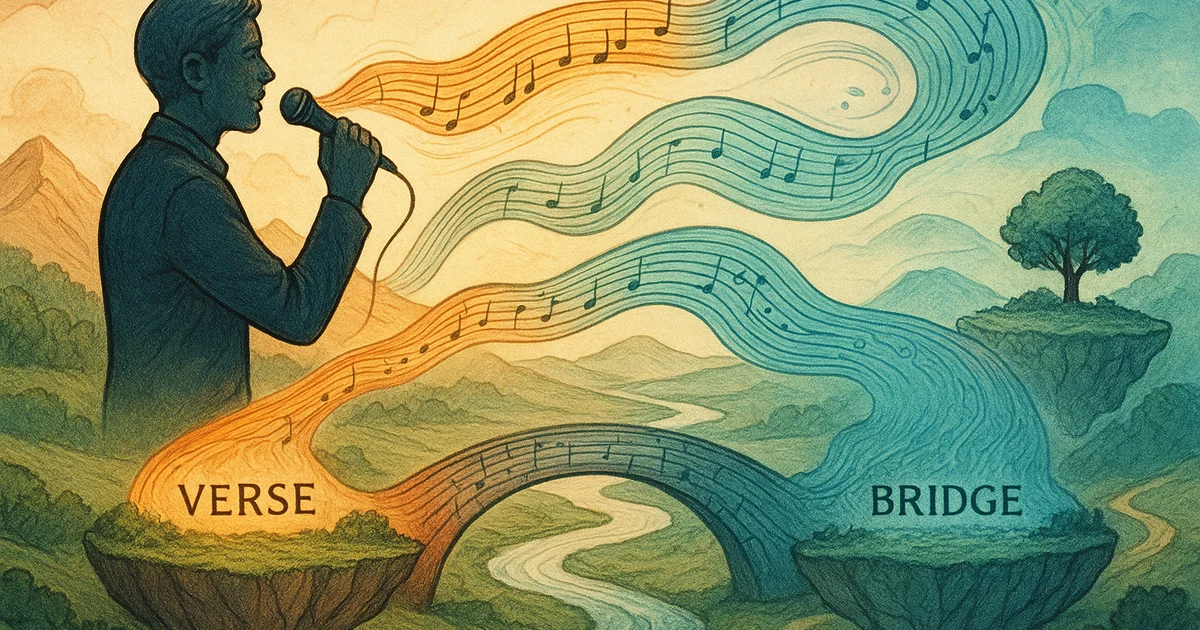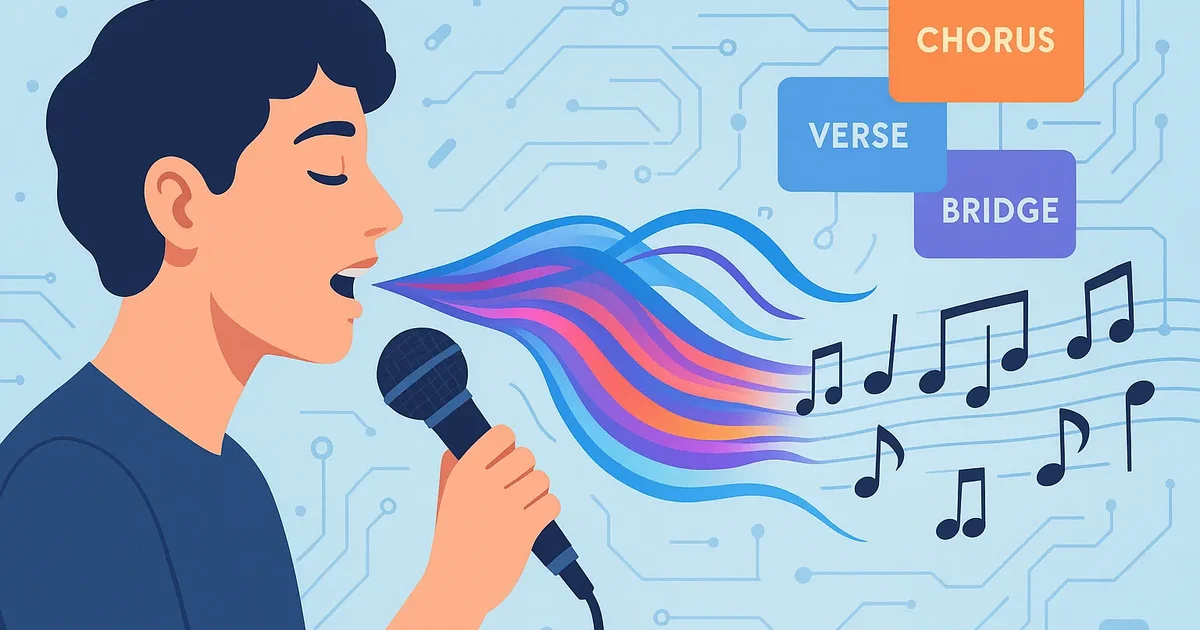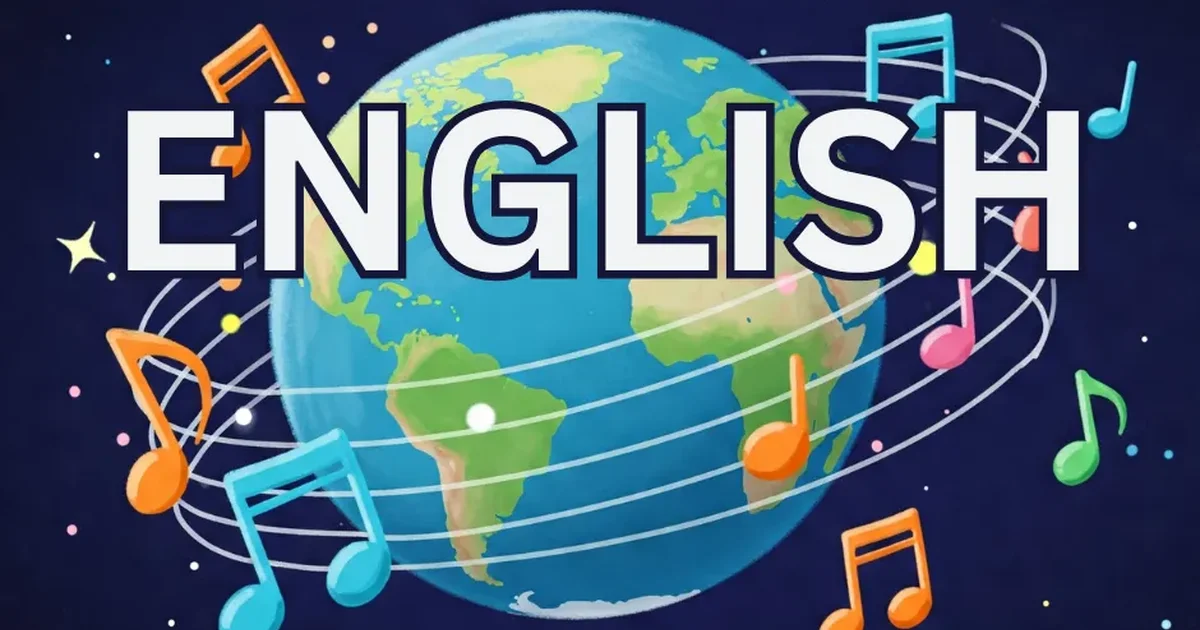Bridge Writing Tool - Create Powerful Song Bridges with AI

The bridge is where your song takes a breath, shifts perspective, and gives listeners something unexpected before returning to familiar territory. It’s the moment that separates good songs from unforgettable ones, yet many songwriters struggle to create bridges that feel natural and necessary rather than forced.
We’ve discovered that voice technology excels at bridge creation because it captures the natural storytelling instincts and emotional shifts that make bridges compelling. When you speak your bridge ideas, the intelligent systems detect changes in tone, pacing, and perspective that translate into powerful lyrical moments.
The Perfect Prompt for Bridge Writing
Here’s the exact approach we recommend for creating impactful bridges:
Voice Input: “Create a bridge that shifts to a more reflective perspective, using nature metaphors to show personal growth, with a slower, more intimate feel than the energetic chorus”
Speaking Tips:
- Describe the emotional or perspective shift you want
- Mention specific imagery or metaphors to explore
- Indicate how the bridge should contrast with other sections
- Include the mood change you’re seeking
Example Output
Here’s what Lyric Genie generated using this storytelling approach:
[Bridge]
Like rivers carving through the stone
I'm finding strength I've never known
The mountains that once blocked my way
Are just the hills I climb todayTitle: “River’s Path”
Style Includes: Introspective bridge, nature metaphors, emotional growth, acoustic feel Style Excludes: Fast tempo, complex arrangements, repetitive phrases
This bridge works because it uses concrete imagery to represent abstract concepts, creating a natural pause that adds depth to the song’s narrative while maintaining thematic consistency.
Advanced Bridge Writing Techniques
Storytelling Perspective Shifts
The most effective bridges change the narrative viewpoint. Instead of continuing the same story, try speaking from a different angle: “Tell this story from five years in the future” or “Show what the other person in this relationship is thinking.” Our voice recognition captures these perspective changes and builds bridges that feel like genuine story developments.
Metaphor Development
Strong bridges often expand on metaphors introduced earlier or introduce contrasting imagery. When recording your bridge idea, think in concrete terms: “Compare this feeling to being lost in a familiar city” or “Use weather metaphors to show changing emotions.” The multimodal analysis understands symbolic language and creates consistent metaphorical frameworks.
Dynamic Contrast Creation
Bridges should feel different from verses and choruses. Speak your bridge ideas with the energy level you want—whisper for intimacy, speak firmly for determination, or use varied pacing for emotional complexity. This natural vocal variation guides the AI in creating appropriate lyrical rhythms and emotional tones.
Connecting Your Song Sections
Thematic Consistency
Your bridge should feel connected to the rest of your song while offering something new. When generating bridge ideas, reference the themes from your verses and chorus: “Create a bridge that answers the question posed in the verses” or “Show the resolution to the conflict described in the chorus.”
Lyrical Flow Integration
Consider how your bridge leads back into the final chorus or outro. Speak your bridge idea while thinking about the transition: “End this bridge with a line that builds anticipation for the final chorus” or “Create a bridge that sets up a key change.”
Emotional Arc Completion
Great bridges complete the song’s emotional journey. Whether your bridge provides resolution, adds complexity, or deepens the mystery, make sure it serves the overall narrative. Voice input naturally captures these emotional intentions because you’re speaking with the feeling you want to convey.
Refining Your Bridge
Imagery Enhancement
Bridges benefit from specific, vivid imagery. Use our editing tools to strengthen visual elements: replace general words with concrete images, add sensory details, or develop metaphors more fully.
Pacing Adjustment
Bridge pacing often differs from other sections. Experiment with line length, pause placement, and rhythm changes to create the right flow for your song’s emotional moment.
Concept Development
Sometimes bridges need to explore abstract concepts more deeply. Use the revision tools to expand philosophical ideas, strengthen thematic connections, or clarify symbolic meanings.
Getting Started with Voice-First Bridge Writing
- Identify the Gap: Determine what your song needs—perspective shift, emotional development, or narrative progression
- Speak the Change: Describe the new viewpoint, feeling, or story element you want to explore
- Use Concrete Language: Include specific metaphors, images, or scenarios
- Consider the Return: Think about how the bridge leads back to familiar territory
The beauty of voice-first bridge writing lies in capturing the natural storytelling rhythms that make bridges feel inevitable rather than inserted. When you speak with genuine intention about the story or emotional shift you want to create, that authenticity translates into bridges that truly serve your song.

